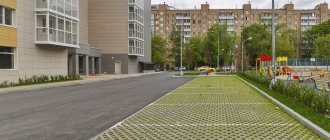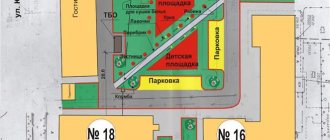Residents of apartment buildings are often faced with a lack of free parking spaces on the premises.
This problem is especially acute in cases where you have to pay for car parking out of your own pocket. This situation forces car owners to resort to a little trick - parking their cars in nearby yards.
In this regard, barrier structures began to appear on the territory of the latter, with the help of which residents of apartment buildings are trying to fight “uninvited guests.”
True, in most cases such structures are installed on not entirely legal grounds, which entails a lot of additional problems. Where can I complain about the illegal installation of a barrier and what could such an initiative lead to?
The legislative framework
The legality of installing a barrier in the yard is regulated by several regulations:
- Art. 36 LC RF and Art. 16 Federal Law of December 29, 2004 No. 189-FZ “On the entry into force of the Housing Code of the Russian Federation” - the land plot on which the apartment building and the real estate objects belonging to it are located is the shared property of the owners;
- clause 1 art. 247 Civil Code of the Russian Federation, paragraph 2 of Art. 218 of the Civil Code of the Russian Federation and clause 2 of Art. 36 of the Housing Code of the Russian Federation - the owner has the right to take any actions in relation to his property, if they do not contradict the law and also do not violate the rights and interests of other persons. Possession and use of property that is in common ownership is carried out with the consent of all its participants or in court (if the parties have not reached agreement);
- clause 2, part 2, art. 44 of the Housing Code of the Russian Federation - decisions on the conditions for using the plot of land on which an apartment building stands (including the introduction of restrictions) must be made at a general meeting of premises owners;
- Clause 1.5 of the Traffic Regulations - it is prohibited to unauthorizedly install traffic lights, road signs, barriers and other means of organizing traffic that may interfere with its implementation.
Considering the fact that the local area is not a road and, in principle, is not suitable for through passage, installing a barrier here is not a violation of traffic rules.
However, this fact does not eliminate the need to submit certain documents to the traffic police.
These include:
- Permits issued by self-government bodies in agreement with the State Traffic Safety Inspectorate, the state fire inspection service and the management company;
- The decision of homeowners to install a barrier, made at a general meeting.
Grounds for complaint
You can complain about a barrier in situations where:
- The issue of installation was not brought up at the general meeting of residents (if we are talking about the local area). Consent must be given by at least 2/3 of the residents of the house (Part 1 of Article 46 of the Housing Code of the Russian Federation), since we are talking about introducing restrictions on the use of the territory. Here the issue of distribution of costs for installation of the enclosing structure must be resolved.
- The installation is carried out in the local area, which is not registered as shared ownership of the residents. The local area has established boundaries, beyond which it is prohibited to install a barrier. They must be indicated in the cadastral passport of the land plot. If such information is missing, it means that the adjacent land was not registered and land surveying was not carried out for it.
- There are no approval documents from local authorities, traffic police, or fire supervision. The first and second must provide a written response about the absence of obstacles to travel and passage on public roads, the third - about the absence of obstacles to the passage of special vehicles.
- Restrictions are created for the unimpeded 24-hour passage of fire equipment, ambulances, police, and other emergency or special services (in the absence of 24-hour security or other methods of implementing this requirement).
- Obstacles are created to prevent residents from accessing their property. If there are protective structures, it is necessary to ensure that everyone can independently open/close the barrier at any time or provide space for the free movement of pedestrians, cyclists, and strollers (for children and the disabled).
When is it illegal to install a fence?
Before you find out where and to whom to write a statement about the illegal installation of a barrier, you need to understand what exactly lies behind this concept.
According to the law, illegal installation of fencing structures is determined by the absence of:
- Permitting documents;
- Clearly defined boundaries;
- Notes on entering information into the cadastre of the adjacent plot of land;
- Consent of the owners of the land plot, as well as
- Violation of technical requirements for the manufacture and placement of the barrier.
Fine for a barrier for a negligent driver
Having seen a previously missing limiter on a familiar section of the road, a motorist should not immediately ram it. It is quite possible that the device was installed legally. And the driver, having damaged it, will himself become a violator. It is even more undesirable to drive under the barrier at a railway crossing.
For broken or knocked down in a paid parking lot
Damage to a barrier in a parking lot by a carelessly moving vehicle will be considered an accident. After all, this is essentially a collision with a road structure. That is, the motorist will “earn” himself at least Article 12.33 of the Administrative Code, and this is a fine of 5,000 - 10,000 rubles.
The amount of payment depends on the circumstances of the case. If the driver damaged the barrier intentionally, and there are other offenses behind it, the punishment will be maximum. In addition, you will have to restore the barrier at your own expense. If the motorist refuses to do this voluntarily, the money will be recovered in court.
Despite the size of the fine, other payments and the apparent insignificance of the incident, you should not leave the scene of the accident. If the motorist who damaged the limiter leaves, he will have to answer under Part 2 of Article 12.27 of the Administrative Code. For leaving the scene of an accident, he will lose his license for 1 - 1.5 years or will be arrested for up to 15 days.
Who should I complain about an illegal design?
Being a full co-owner of the local area, any resident of an apartment building who discovers the illegal installation of a barrier has the right to demand the dismantling of the illegal building.
What to do if a barrier is installed in the yard? First, you need to find out what violations were committed during its installation (whether all the necessary permits and documents are available, whether the meeting was held correctly, whether there are signatures from all residents of the house, etc.), and only after that file a complaint with the appropriate authority.
Where can I complain about an illegally installed barrier? The following bodies deal with this issue (their choice depends on the type of violations detected):
- Housing inspection - checks the correct organization and conduct of the general meeting. If it was carried out with violations or there is no decision at all, a housing inspectorate employee may issue an order to the HOA or management organization;
- City Administration . If a barrier encloses public spaces or blocks passage along a public city street, local authorities have the right to apply to the court to demand its demolition;
- Fire protection . The Ministry of Emergency Situations evaluates the installation of a barrier from the point of view of restricting the passage of special vehicles;
- Traffic police . If a barrier interferes with movement on public roads, traffic inspectors may prohibit its installation;
- Prosecutor's office . This body has the most extensive powers, so it is turned to in cases where it is difficult for the applicant to determine the presence of illegal actions when installing a barrier.
If the above inspections decided that the barrier was illegal, but its dismantling was never carried out, it is worth going to court. Based on the results of the consideration of the case, the court decision will be subject to forced execution at the expense of the violator.
Question answer
Question: A barrier recently appeared in the courtyard of our high-rise building. I know that this is municipal land, but there are also no permits from the municipality and fire departments for the installation. In addition, they offer to buy a key for unhindered use for 700 rubles. Where can I complain?
Answer: Such actions can be qualified as arbitrariness (Article 19.1 of the Code of Civil Procedure of the Russian Federation). In this regard, you should complain to the prosecutor's office, in addition, you can send complaints to any of the authorities indicated by you.
Question: How to check the legality of installing a barrier if the building council refused to provide permits?
Answer: If it is not possible to familiarize yourself with the documents, you can check the legality of the installation of the enclosing structure through a written application to the municipal administration or by contacting the prosecutor's office.
Question: What happens if a barrier installed illegally in the courtyard of an apartment building is broken?
Answer: Damage to property is grounds for prosecution, collection of a fine and the cost of the damaged property. To protect your interests, it is better to use legal methods of struggle: first make sure that the placement is illegal, and then file complaints with the appropriate authorities.
Question: I complained to the traffic police about the installation by neighbors of a barrier that blocked part of the street. How long does it take to consider my application?
Answer: In general, the review period is 30 days.
Question: On what grounds can I appeal the decision of the general meeting of residents to install a barrier if I was absent from it?
Answer: If the decision was made by more than 2/3 of the votes of the residents, it also applies to all owners who did not take part in the vote or were against it. If it is adopted by a simple majority of votes, the owner who opposes has the right to appeal its results in court or appeal to the above authorities.
What are the consequences of illegally installing a barrier?
According to the legislation in force in Russia in 2021, the unauthorized installation of barrier structures and the lack of permitting documents is a serious administrative violation, which is punishable by a considerable fine:
- For individuals – up to 2 thousand rubles;
- For officials – from 7 to 10 thousand rubles;
- For legal entities – from 120 to 150 thousand rubles;
- If the road surface is damaged during installation - from 5 to 10 thousand rubles.
Fines for illegal structures can be imposed repeatedly and not by one, but by several authorities at once. The only option is to legalize the barrier or remove it (at your own expense, of course).
It should also be noted that if a fire or any other emergency occurs in the area with the barrier, and access for the rescue service is not opened in a timely manner, the owner of the barrier structure will face not only additional material costs, but also a more serious penalty. In this case, the fence can be demolished without compensation for its construction.
The following measures will help you avoid problems:
- Connecting the barrier to a concierge service or a 24-hour security point;
- Installation of a watchman's booth from which direct control of the barrier will be carried out. In this case, the watch must be maintained around the clock;
- Concluding an agreement with a company for remote maintenance of barrier devices. Most often, they are provided by the company that installed the barrier;
- Providing emergency response services with electronic key fobs.
City services can find out about an unauthorized barrier erected without complaints. As a rule, such structures are discovered during regular inspections of streets and yards carried out by employees of the State Real Estate Inspectorate.
Installation procedure and cost of installation work
After obtaining permission to install a barrier, it is necessary to ensure unhindered access of vehicles to special authorities and services:
- housing and communal services;
- police;
- ambulance;
- firefighters;
- gas service;
- other.
To ensure the conditions and requirements, it is necessary to hire security or a concierge, whose responsibilities will include operating the equipment. Another option for resolving the issue is to provide special services with key fobs for entering the territory of the residential complex.
Note: installation of an artificial fence should be carried out within 60 days after receiving permission from the administration of the locality.
Within a month after installation, you must send confirmation to the authorities about the completion of the work. The owner's representative submits a package of papers to the Housing and Communal Services Department:
- contract with the contractor for installation of the device;
- acceptance certificate for the installation of an artificial fence at the entrance to the courtyard of the house.
Read also: Place of actual residence
The minimum cost of equipment installation work is 40,000 rubles. The price, first of all, depends on the type of barrier.
The procedure for installing a barrier on the territory of the house
So that other residents of an apartment building do not have questions about how to deal with an illegally installed barrier, all actions related to its installation must be carried out in accordance with current legislation.
As mentioned earlier, such decisions must be made at a general meeting and recorded in the appropriate minutes. At the same time, at least 51% of all premises owners must vote for the installation of the fence.
Among other things, at such a meeting it is possible to resolve the issue related to the organization of entry through the barrier for personal vehicles and transport of public utility and emergency services (meaning ambulances, police, etc.).
There are also a few important points to consider:
- Due to the fact that the barrier can only be installed within their own land plot, its owners must submit an application to register the plot of land with the cadastral register;
- The installation of fencing structures should not interfere with the access of all residents of the house to their homes (this is especially true for disabled people, mothers with strollers and citizens on foot - there should be a fairly large passage for them). To do this, each owner of the premises must be given the opportunity to open the barrier independently;
- Before carrying out installation work, it is necessary to obtain written permission from the local administration, the Ministry of Emergency Situations, the State Fire Inspectorate department, the traffic police and the electric grid company;
- The barrier itself must correspond to the type, design, size and location specified in the approval document. Otherwise, it may also be considered illegal.
Installing a barrier in the courtyard of a residential building: law, rules, what is needed for this
In what cases will installing a barrier in the yard of a residential building be legal, and in what cases will it result in serious problems and a fine? We propose to find out whether the neighbor is right to fence off his “personal” parking space in front of the entrance with a homemade barrier and where to go to get the fences made according to the law.
Instructions for legal installation of fencing
Installing a barrier in the courtyard of a residential building will be legal if you follow the letter of the law and remember all the regulations.
Step 1 - determine the status of the site
First, you need to make sure that the area chosen for installation is not a road, because in this case, installing a fence will be illegal, because according to Article 17.1 of the Traffic Rules in a residential area (yard areas) “unreasonable interference” should not be created for cars.
The rules for installing a barrier in the courtyard of a residential building stipulate that the barrier can only be installed on territory that belongs to residents, but is not a road for through traffic.
Step 2 – registration of shared ownership
The selected area must be listed on the documents as a local area. If this is the case, then we can safely skip this step. If there are no such papers, then they will have to be issued. Otherwise, the yard belongs to the city, which means that anyone can drive through it freely and park.
On a note! Registration of shared ownership of common land is carried out on the basis of Federal Law No. 122 of July 21, 1997.
It is important to know when the house with all adjacent buildings and land was put into operation:
if before the entry into force of the Housing Code (before March 1, 2005), then the entire object was automatically transferred into common shared ownership and registered in the cadastral register,
if after, then you will have to fill out the documents and register the plot yourself, having previously submitted an application to the local government authorities with a request to allocate a land plot for subsequent registration.
With documents confirming the right of common ownership, on the basis of Article 36 of Article 2 of the Housing Code, residents can use and dispose of common property at their own discretion.
Step 3 – general meeting
Talking to your neighbors and getting their consent to install a barrier for strangers is not enough. A mandatory general meeting is required. It is the meeting of the owners of residential premises under Article 44 (Parts 1, 2) of the Housing Code of the Russian Federation that must decide how to dispose of common property, including a land plot.
Important! If the yard belongs to several houses, then everyone needs to be collected in order to avoid future claims from those for whom the new fence will interfere.
The following points need to be agreed upon at the meeting:
whether to install a fence or not,
which company to enter into an agreement with,
what kind of fencing is required - automatic, locked with a key, with an established duty (hiring a concierge or a queue of residents).
On a note! To make a decision, according to the law, signatures from 51% of the owners are sufficient, but to successfully pass all approvals, it is better if at least 70% agree.
The result of the meeting should be a protocol that reflects the agreement of the majority on all issues that were put on the agenda.
Step 4 - choosing an artist
Residents must collectively vote for the organization that will be assigned the responsible task. It is clear that anyone can nominate contractors, and not only the cost of installing a barrier in the courtyard of an apartment building should determine the final choice.
What you need to install a barrier in the yard can be obtained from the company that will install the equipment:
technical installation plan, in which the fence will not cause difficulties for the passage of special vehicles (firefighters, ambulances, police, emergency services, etc.),
an estimate with a detailed calculation of what you will have to pay for,
signed official contract with warranty obligations.
On a note! The barrier is not a capital object, so there is no need to obtain a separate building permit.
The ideal protection for clear passage through your yard should meet the following criteria:
do not obstruct pedestrians of all categories: parents with strollers, disabled people, elderly people, etc., as well as cyclists,
the boom must be made of high-quality but lightweight material (in case of extreme need for forced opening or dismantling in case of malfunction),
safe to operate (ideally, if emergency stop mechanisms are provided for the lowering boom when, say, a child unexpectedly appears under it),
concrete base so that the barrier is durable,
warranty period of operation,
design that is noticeable at night not only to motorists, but also to pedestrians (this could be glow-in-the-dark stripes or a place illuminated by a street lamp).
Step 5 – approvals
We need to remember those who check the legality of installing a barrier in the yard and issue permits. This:
The State Traffic Inspectorate, which may see an obstacle as a restriction of travel through the through territory,
fire inspection, which will check whether its vehicles can freely approach the house if necessary.
In order not to be refused when agreeing to install a barrier in the yard:
When contacting the traffic police, the application must indicate that the selected site is not a road, but belongs to the local area (residential area), through which traffic is prohibited on the basis of Article 17 (clause 2.4) of the Traffic Regulations (attach documents on the status of the site) ,
it is enough for the fire inspector to demonstrate the possibilities of quickly opening the barrier (for example, there is always a guard nearby or the contact numbers of the one who promptly raises the boom are indicated).
If fire services discover the illegal installation of a barrier in the yard, they will issue an administrative fine (Article 20.4, Part 8 of the Administrative Code):
1-2 thousand rubles – for citizens,
7-10 thousand – for officials,
Who should pay for the installation of the barrier?
The distribution of costs for the installation of a fencing structure, which is also discussed at the general meeting, causes a lot of controversy. In some cases, it comes to the point that people who do not hand over money may not be allowed into the yard!
It is in this regard that the question often arises: “What to do if the neighbors installed a barrier in the yard and demand money for its manufacture and installation?”
Let's start with the fact that in accordance with Art. 44-46 of the Housing Code of the Russian Federation, the general meeting of owners of an apartment building is considered to be the authorized management body for the use of courtyard areas.
This means that the decision to pay for the manufacture, installation and maintenance of the barrier cannot be made without the knowledge of all homeowners.
At the same time, documentation of all resolutions must be provided to the owners upon request (regardless of whether they attend meetings or not, whether they are “activists” or “dissenters”).
This is where you should look for a solution to all problems! As practice shows, it will not be difficult for an experienced lawyer to find certain inconsistencies in these documents that call into question the legality of such actions.
But that is not all! According to the land management and town planning codes of the Russian Federation, the “adjacent territory of an apartment building” is considered to be the adjacent area specified in the regulatory documentation.
This plot may belong to the municipality, or it may be registered as shared ownership of the residents . In the latter case, each owner regularly pays a tax, which gives him the right of unhindered access to the territory of the house.
If the local area is owned by the municipality, then the activists who installed the barrier and demand money for it are required to provide a legal basis for the disposal of city property. The legality of this document can also be checked at a law office.
No less stringent requirements are put forward for the organization of the meeting itself . Firstly, notification of its holding should appear no later than 10 days before the appointed date.
Secondly, this message must be issued in accordance with paragraph 5 of Art. 45 Housing Code of the Russian Federation . Otherwise, both the meeting itself and all decisions made at it will be considered invalid.
Knowing how to remove a barrier in the yard if gross violations were committed during its installation, you will be able to defend your rights without any problems.
Legality of installation
Also read Do you need a license for a well in SNT?
Unfortunately, a barrier does not always solve the issue of safety for members of the partnership. Sometimes the chairman pursues completely different goals with such actions. For example, self-interested ones - the structure is installed at the expense of contributions from the participants of the partnership, and the profit from its use goes “into the pocket” of the manager. Income, as a rule, is associated with the entry of seasonal retail stores and other outsiders.
Legality will be observed if permission for these actions is received from all members of the community at a general meeting. According to the law, no one has the right to prevent the owner from entering his land plot. And if the majority decided to limit access to the territory of the gardening partnership to third parties, the owners of the plots should not suffer from this, regardless of whether they contributed money for the construction of the structure or not.
The chairman does not have the right to prohibit the owner from entering his land plot as a punishment for non-payment of membership fees. The debt must be collected through the court, but driving through the barrier is a separate issue.
Let's consider the situation: a person inherited a plot of land on the territory of a partnership, wants to sell it, but does not intend to join the partnership, even temporarily. What's the point of him throwing himself at the barrier? The issue must be resolved peacefully, so that the safety of the owners is ensured, and the rights of other persons are not infringed.







